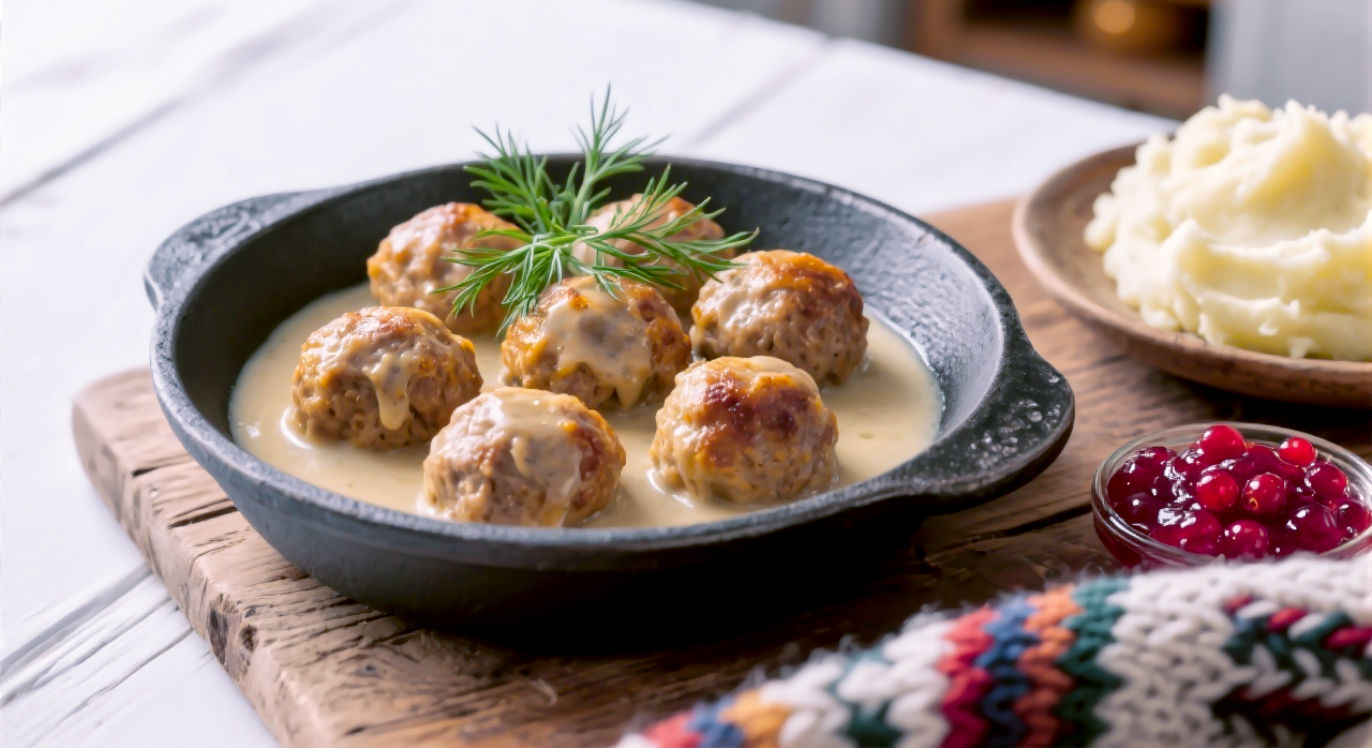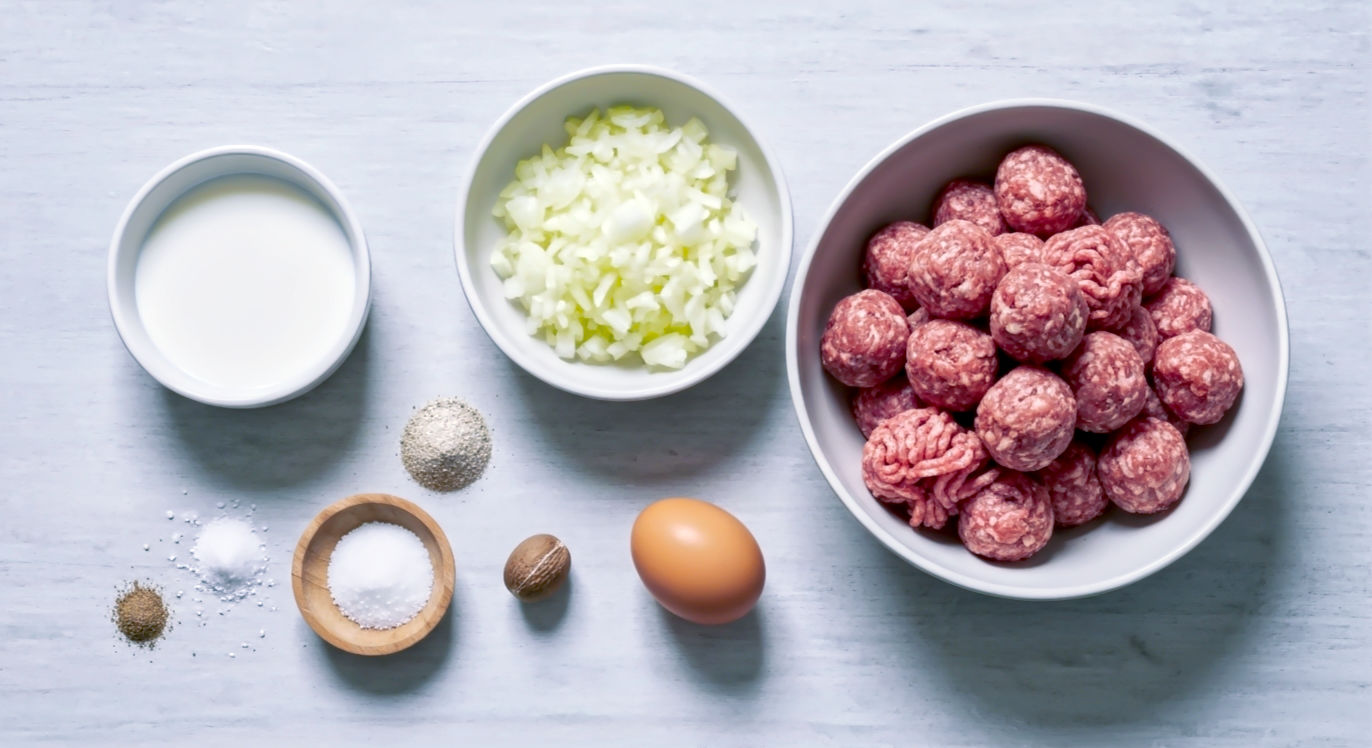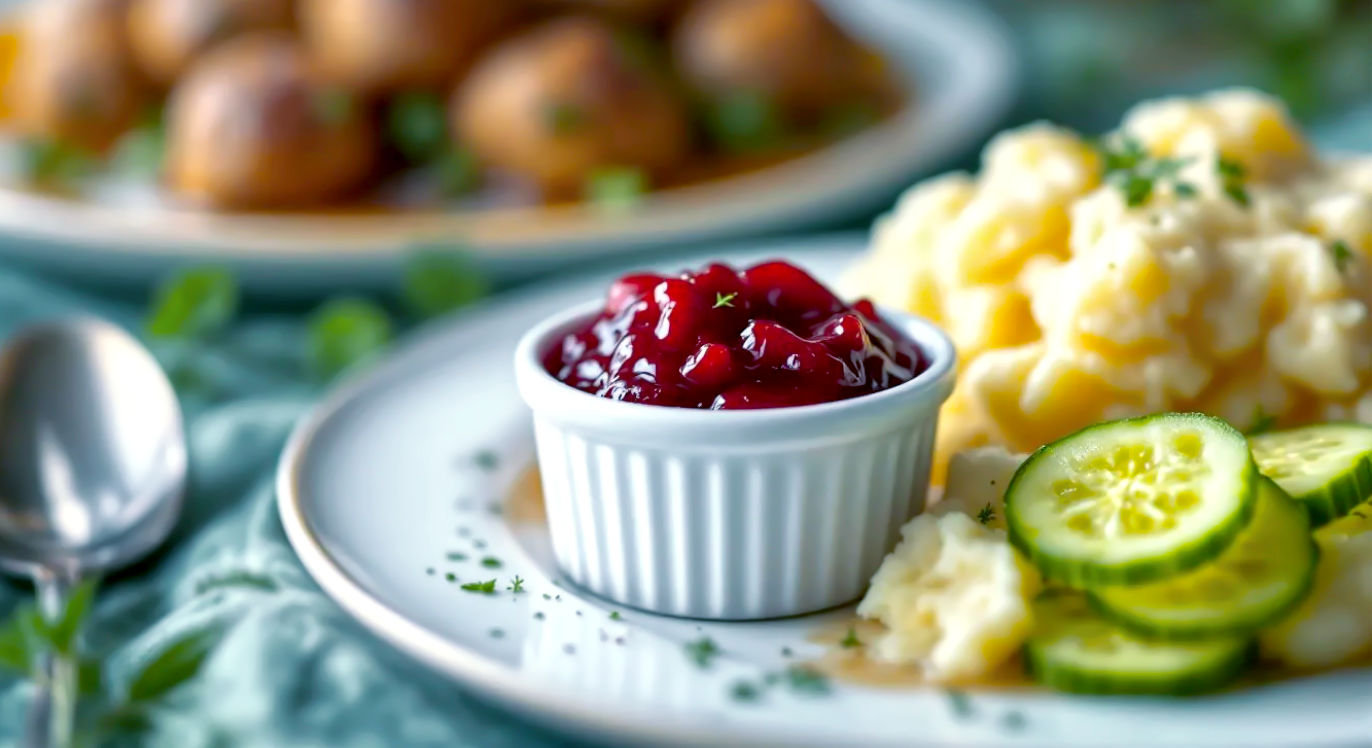The Guide to Perfect Homemade Swedish Meatballs: A British Cook’s Companion
Our ultimate guide shows you how to make perfect, tender homemade Swedish meatballs and a gloriously creamy gravy from scratch. Simple and delicious.

This post may contain affiliate links. If you make a purchase through these links, we may earn a commission at no additional cost to you.
Let’s be honest. For many of us in the UK, our first encounter with Swedish meatballs wasn’t in a cosy Stockholm restaurant, but under the harsh, unforgiving lights of a canteen in a blue and yellow big-box store on a rainy retail park. After navigating a maze of flat-pack furniture, they were a welcome, gravy-soaked reward. And they’re not bad, are they? But what if I told you that the real thing—the ones you can make in your own kitchen—are on an entirely different level?
We’re talking about meatballs so tender they practically melt in your mouth. A gravy so creamy, savoury, and rich you’ll want to mop up every last drop with a bit of bread. And a flavour profile so comforting it feels like a warm hug on a dreary Tuesday night.
This isn’t just a recipe. This is your definitive guide to mastering köttbullar (that’s ‘meatballs’ in Swedish, pronounced roughly ‘shut-boo-lar’). We’ll go beyond a simple list of ingredients and delve into the history, the science, and the secrets that separate good meatballs from truly unforgettable ones. Forget the Allen key and confusing diagrams; this is one Swedish creation that’s a pure joy to put together. So, roll up your sleeves, put the kettle on, and let’s make the best Swedish meatballs you’ve ever tasted.
The Anatomy of a Perfect Swedish Meatball: What’s the Secret?
Before we even touch a mixing bowl, it’s crucial to understand what makes a Swedish meatball… well, Swedish. It’s not just a lump of mince rolled into a ball. It’s a delicate balance of four key elements that work in harmony. Get these right, and you’re already halfway to perfection.
The Meat: A Partnership of Pork and Beef
The first rule of Swedish meatballs: don’t just use beef. While a 100% beef meatball has its place (hello, spaghetti), it can often be a bit dry and dense for this dish. The magic lies in a 50/50 blend of pork and beef mince.
- Beef Mince (15-20% fat): This brings the deep, savoury, meaty flavour. It’s the backbone of the meatball. Don’t be tempted by the super-lean stuff; fat equals flavour and moisture, and we need both.
- Pork Mince (at least 20% fat): This is the secret to a tender, juicy texture. Pork fat has a lower melting point, which helps to keep the meatballs succulent as they cook. It adds a subtle sweetness that perfectly complements the beef.
This combination gives you the best of both worlds: robust flavour from the beef and a light, tender bite from the pork.
The Panade: The Unsung Hero of Tenderness
Ever had a meatball that was tough, rubbery, and dense? The culprit is almost always a lack of a panade. This sounds fancy, but it’s incredibly simple. A panade is a mixture of a starch (usually bread or breadcrumbs) and a liquid (usually milk or cream) that you mix into the meat.
Here’s the clever bit: The starch and liquid form a sort of gel. When you mix this into the mince, it gets trapped between the protein strands of the meat. As the meatballs cook, the proteins tighten up. Without a panade, they squeeze together tightly, forcing out moisture and resulting in a tough little ball. But with the panade in there, the gel keeps the protein strands separated, trapping moisture and fat inside.
The result? An incredibly tender and juicy meatball. It’s a non-negotiable step, and it takes about two minutes.
The Spices: A Whisper of Warming Allspice
What truly distinguishes the flavour of a Swedish meatball from its Italian cousin is the spice blend. It’s subtle, warming, and deeply comforting. The key players are:
- Allspice: This is the soul of the Swedish meatball. It’s often mistaken for a blend of spices, but it’s actually a single berry from a Caribbean tree. It tastes like a combination of cinnamon, nutmeg, and cloves. It brings a gentle, aromatic warmth that is absolutely essential.
- Nutmeg: Often grated fresh, nutmeg adds a sweet, slightly woody fragrance that pairs beautifully with the creamy sauce.
- White Pepper: Why white and not black? White pepper has a more earthy, less pungent heat. It blends seamlessly into the background, providing a subtle warmth without leaving little black specks in your pale, creamy gravy.
These spices, combined with finely chopped onion (which we’ll sauté first to soften its flavour), create that signature, gently spiced taste.
The Gravy (Gräddsås): The Creamy Cloak of Glory
The meatballs are only half the story. A proper Swedish meatball is nothing without its gräddsås (cream sauce). This isn’t your typical Bisto gravy you’d pour over a Sunday roast. It’s pale, creamy, and built from the delicious browned bits left in the pan after frying the meatballs.
The foundation is a simple roux (a mix of butter and flour) cooked in the meatball pan. This thickens the sauce and adds a nutty depth. Then comes rich beef stock and, finally, a generous splash of double cream to give it that luxurious, silky texture. A dash of soy sauce for umami saltiness and a touch of Dijon mustard for sharpness are the final touches that bring it all together.
A Brief, Delicious History: More Than Just a Meal
While IKEA may have made them a global phenomenon, köttbullar have been a staple of Swedish home cooking for centuries. The story often told is that King Charles XII brought the recipe back from the Ottoman Empire (modern-day Turkey) in the early 18th century. While it makes for a good tale, food historians reckon that meatballs in various forms popped up all over the world organically.
What is certain is that they became deeply embedded in Swedish culture. They were an efficient way to use up leftover scraps of meat, which were ground with filler like breadcrumbs or potato to make them go further. They became a centrepiece of the traditional smörgåsbord, a buffet-style meal laden with various hot and cold dishes.
Today, they are the ultimate Swedish comfort food, served everywhere from family dinner tables to fine-dining restaurants. They are a non-negotiable part of the Christmas feast (julbord) and a beloved national dish that evokes a sense of home, tradition, and simple, hearty satisfaction.
The Definitive Recipe: Your Step-by-Step Guide to Perfection
Right, theory over. Let’s get our hands dirty. This recipe will serve four hungry people, likely with a few delicious leftovers.

Ingredients
For the Meatballs (Köttbullar):
- 400g beef mince (15-20% fat)
- 400g pork mince (at least 20% fat)
- 1 large white onion, very finely chopped
- 1 tbsp unsalted butter (for the onion)
- 80g fresh white breadcrumbs (from about 2-3 slices of stale bread, crusts removed)
- 150ml whole milk or double cream
- 1 large free-range egg, lightly beaten
- 1 tsp salt
- ½ tsp ground white pepper
- ½ tsp ground allspice
- ¼ tsp freshly grated nutmeg
- 2 tbsp unsalted butter or a mix of butter and neutral oil (for frying)
For the Creamy Gravy (Gräddsås):
- 40g unsalted butter
- 40g plain flour
- 500ml good-quality beef stock, preferably hot
- 150ml double cream
- 1-2 tbsp soy sauce (to taste)
- 1 tsp Dijon mustard
- A pinch of salt and white pepper, to taste
- A squeeze of fresh lemon juice (optional, to brighten)
To Serve (The Holy Trinity):
- Creamy mashed potatoes
- Lingonberry jam (you can find this in most large supermarkets or, you guessed it, IKEA)
- Quick pickled cucumbers
Method: Step-by-Step to Meatball Mastery
Part 1: Making the Meatballs
- Prepare the Panade: In a small bowl, mix the breadcrumbs and the milk (or cream). Give it a good stir and set it aside for at least 10 minutes. It should become a thick, porridge-like paste. This is the secret to tender meatballs, so don’t skip it!
- Sauté the Onion: While the panade is soaking, melt 1 tbsp of butter in a small frying pan over a medium heat. Add the very finely chopped onion and cook gently for 5-7 minutes until it’s soft, translucent, and sweet. Don’t let it brown. Scrape the softened onion into a large mixing bowl and let it cool completely. Cooking the onion first removes its raw, sharp bite.
- Combine the Mixture: To the bowl with the cooled onions, add the pork and beef mince, the soaked panade, the beaten egg, salt, white pepper, allspice, and nutmeg.
- Mix (But Don’t Over-mix!): This is a critical step. Using your hands (it’s the best way!), gently combine all the ingredients until they are just incorporated. If you overwork the mixture, you’ll develop the gluten in the meat proteins, leading to tough, bouncy meatballs. Mix only until everything looks uniform.
- Shape the Meatballs: Have a small bowl of water nearby to wet your hands; this stops the mixture from sticking. Roll the mixture into small, uniform balls, about 1 to 1.5 inches in diameter – roughly the size of a walnut. Place them on a tray or large plate lined with baking parchment. You should get between 40 and 50 meatballs.
Part 2: Cooking the Meatballs and Making the Gravy
- Fry the Meatballs: Melt the 2 tbsp of butter/oil in a large, heavy-bottomed frying pan or skillet (cast iron is brilliant here) over a medium-high heat. Working in batches so you don’t overcrowd the pan, carefully place the meatballs in the hot fat. Fry for 5-8 minutes, turning them regularly with tongs, until they are beautifully browned on all sides and cooked through. Remove the cooked meatballs to a clean plate and set aside. Repeat with the remaining meatballs.
- Start the Gravy (in the Same Pan!): Do not clean the pan! Those browned, caramelised bits stuck to the bottom are pure flavour gold. Reduce the heat to medium and add the 40g of butter. Let it melt and scrape up some of those bits with a wooden spoon.
- Make the Roux: Once the butter is foaming, sprinkle over the 40g of plain flour. Whisk it constantly for about 2 minutes. It will form a thick paste (a roux) and should smell slightly nutty. Cooking the flour like this gets rid of its raw taste.
- Build the Sauce: Gradually, a splash at a time, pour in the hot beef stock, whisking vigorously all the while. Adding the hot stock to the hot roux slowly is the key to a lump-free gravy. Once all the stock is incorporated, the sauce should be smooth and slightly thickened.
- Finish and Refine: Let the sauce bubble gently for a few minutes to thicken further. Then, turn the heat down to low and stir in the double cream, soy sauce, and Dijon mustard. Let it warm through but don’t let it boil once the cream is in. Have a taste. Does it need more salt? A bit more white pepper? A tiny squeeze of lemon juice can sometimes brighten up all the rich flavours.
- Bring it All Together: Gently return the cooked meatballs to the pan with the gravy. Let them simmer very gently for 5-10 minutes to heat through and soak up some of that glorious sauce.
- Serve Immediately: Spoon the meatballs and generous amounts of gravy over a bed of creamy mashed potatoes. Add a dollop of sharp, sweet lingonberry jam on the side and a few slices of pickled cucumber. Perfection.
Technique is Everything: The Secrets the Pros Know
Following the recipe will give you a great result. But following these tips will elevate your meatballs to legendary status. This is the difference between cooking and crafting.
The Panade Perfected
For the most tender result, use fresh breadcrumbs from a simple white loaf, not the dry, sandy ones from a packet. They absorb the liquid much better. Some traditional recipes even call for soaking the bread in double cream instead of milk for an even richer, more decadent meatball.
The Chill Factor
Once you’ve rolled your meatballs, if you have time, pop them in the fridge uncovered for 30 minutes. This helps them firm up, making them less likely to fall apart when you fry them.
The Uniformity Trick
Want perfectly round, evenly sized meatballs? Use a small ice cream scoop or a melon baller to portion out the mixture. This ensures they all cook at the same rate and look beautifully professional on the plate.
Frying vs. Baking: The Great Debate
While frying in a pan gives you the best crust and those all-important browned bits for the gravy, it can be a bit of a faff. If you’re short on time or making a huge batch, you can bake them. How to do it: Arrange the meatballs on a baking tray lined with parchment. Bake at 200°C (180°C Fan) for 15-20 minutes, or until cooked through. The downside? You won’t have the pan drippings to start your gravy, so you’ll have to build the flavour from scratch. For the best taste, frying is king.
Gravy Gold
The single most important tip for a flavourful gravy is using the same pan. All the little caramelised meat juices left behind after frying are called ‘fond’. When you add the butter and stock, you’re ‘deglazing’ the pan, lifting all that concentrated flavour up into your sauce. If you wash the pan, you’re literally washing flavour down the drain.
Serving Suggestions: The Holy Trinity and Beyond
The classic Swedish way to serve köttbullar is non-negotiable for your first time.

- Creamy Mashed Potatoes: The perfect fluffy vehicle for that incredible gravy. Mash them with plenty of butter and a splash of milk or cream until they’re silky smooth.
- Lingonberry Jam: This is not just a garnish; it’s essential. The sharp, tart, and slightly sweet flavour of the lingonberries cuts through the richness of the meatballs and cream sauce. It’s the perfect counterpoint. Cranberry sauce is an acceptable substitute if you’re in a real pinch, but it’s not quite the same.
- Quick Pickled Cucumbers (Pressgurka): Another element of contrast. The sharp, vinegary crunch provides a refreshing bite that cleanses the palate. To make a quick version, thinly slice a cucumber and toss it with a splash of white vinegar, a pinch of sugar, and a pinch of salt. Let it sit for 20 minutes. Done.
Beyond the classics, these meatballs are also fantastic served with buttered egg noodles or even just a chunk of crusty bread for mopping.
Common Pitfalls & How to Dodge Them Like a Pro
Even the best cooks can run into trouble. Here’s a quick troubleshooting guide.
Variations on a Classic Theme
Once you’ve mastered the classic recipe, feel free to experiment.

- Different Meats: For a taste of the Swedish countryside, try using a mix of pork and venison mince. You could also use chicken or turkey mince for a lighter version, though you’ll need to be extra careful not to overcook it.
- Gluten-Free Version: Swap the breadcrumbs for a gluten-free variety and use a gluten-free plain flour blend or cornflour to thicken the gravy.
- Dairy-Free Version: Use a plant-based milk (like oat milk) and bread for the panade. Use oil instead of butter for frying. For the gravy, use a good quality oat-based cream alternative and a dairy-free butter block for the roux. The flavour will be slightly different, but still delicious.
Pairing Your Masterpiece: What to Drink
To complete the experience, a good drink pairing can make all the difference. A light, crisp lager or a pilsner cuts through the richness of the cream sauce beautifully. If you prefer wine, a light-bodied red with good acidity, like a Pinot Noir, would be a lovely match. For a non-alcoholic option, the traditional Swedish drink of lingondricka (lingonberry cordial diluted with water) is the perfect partner.
From Swedish Canteen to Your Kitchen Table
There you have it. The complete journey to creating Swedish meatballs that are worlds away from the flat-pack version. It’s more than just a meal; it’s a process. It’s the smell of onions softening in butter, the gentle warmth of allspice, the satisfaction of watching a gravy come together into a silky, savoury dream.
This is proper comfort food, the kind that makes a house feel like a home. It’s a dish that proves that sometimes, the most impressive meals are born from the simplest, most honest ingredients. Give it a go. I promise you, once you’ve tasted the real thing, you’ll never look at that yellow and blue building in the same way again.
Further Reading:
- BBC Good Food – Swedish Meatballs
- Sweden.se – The official site of Sweden on Swedish food culture
- Serious Eats – The Science of Making the Most Tender Meatballs
- ScandiKitchen – A London-based authority on Scandinavian food




